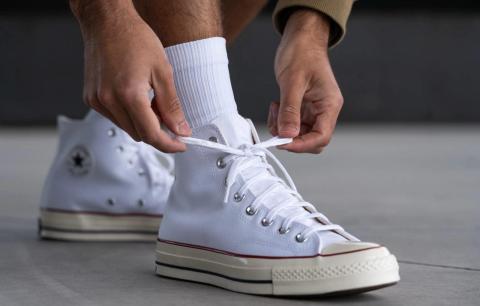
Are Converse Good for Running and Hiking? A Detailed Explanation
Published on March 25 by Matt
Converse sneakers have been a fashion staple for decades, known for their classic design and versatility. However, when it comes to athletic activities like running and hiking, many wonder if Converse shoes are a practical choice. While they may work for casual walking, they are not ideal for high-impact activities such as running or challenging hikes. Here’s a detailed look at why Converse may or may not be suitable for these activities.
Are Converse Good for Running?
Converse sneakers, particularly the Chuck Taylor All Stars, were originally designed as basketball shoes. While they have remained popular over the years, their design lacks the key features needed for efficient and safe running. Here’s why:
1. Lack of Cushioning and Support
- Converse shoes have flat soles with minimal arch support and cushioning, making them uncomfortable for long-distance running.
- Running requires shoes that absorb shock to protect the joints, which Converse lacks.
2. Poor Shock Absorption
- The thin rubber soles provide little to no shock absorption, which can lead to discomfort or injury over time.
- Running on hard surfaces, such as pavement, in Converse can strain your feet, knees, and lower back.
3. Heavy and Rigid Design
- Converse sneakers are heavier than specialized running shoes, which can slow down your performance.
- The canvas upper does not provide the flexibility needed for natural foot movement during a run.

Are Converse Good for Hiking?
Hiking requires shoes with durability, support, and traction to handle rough terrain. Converse shoes, while stylish, are not built for the demands of hiking. Here’s why they fall short:
1. Insufficient Traction
- Converse soles are designed for flat indoor surfaces rather than rough, uneven hiking trails.
- They lack deep treads or grip, increasing the risk of slipping on wet or rocky terrain.
2. Lack of Ankle Support
- Hiking often involves uneven surfaces, and ankle support is crucial to prevent injuries.
- Converse shoes have a soft canvas upper that provides little to no ankle stability, increasing the risk of sprains.
3. Poor Water Resistance
- The canvas material easily absorbs water, making them a poor choice for wet or muddy trails.
- Wet Converse shoes can become uncomfortable and heavy, leading to blisters and foot fatigue.
4. Limited Durability for Outdoor Conditions
- Converse shoes are not built for rugged conditions and can wear out quickly when exposed to rough terrains and elements.
When Can You Wear Converse for Casual Outdoor Activities?
While Converse shoes are not suitable for running or hiking, they can still be a good option for light outdoor activities such as:
- Casual walks on paved paths or sidewalks.
- Urban exploration or city sightseeing.
- Short strolls on dry and even terrain.
Conclusion: Stick to Specialized Shoes for Running and Hiking
If you’re serious about running or hiking, investing in proper footwear designed for those activities is crucial. Running shoes provide cushioning, shock absorption, and flexibility, while hiking boots offer traction, ankle support, and durability. While Converse sneakers are stylish and comfortable for casual wear, they simply don’t meet the requirements for high-performance outdoor activities. For the sake of comfort and injury prevention, it’s best to choose the right shoes for the job.